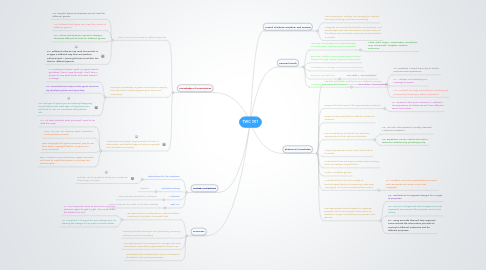
1. Processes
1.1. Be aware that it usually takes multiple drafts to create and complete a sucessful text
1.1.1. C1- You may even have to do it over and over and over again to get it right. The more drafts the better turn out.
1.1.2. C5- Construct a line grid for your design prior to starting the design it may help minimize drafts.
1.2. Develop flexible strategies for generating, revising, editing, and proof-reading
1.3. Use appropriate technologies to manage data and information collected or generated for future use
1.4. Understand the collaborative and social aspects of research and writing processes
2. Knowledge of Conventions
2.1. Learn common formats for different genres
2.1.1. C2- Specific types of emphasis can be used for different genres
2.1.2. C3- Different font types can meet the needs of different genres
2.1.3. C6- Where and what you repeat in designs develops different formats for different genres.
2.1.4. C7- Different cultures may read documents or images a different way than we (western cultures) read. Meaning that we must alter the flow for different genres.
2.2. Develop knowledge of genre conventions ranging from structure and paragraphing to tone and mechanics
2.2.1. C1-Looking at others' work is a good idea to get ideas ( don't copy though). It will help a person to see what works and what doesn't in design.
2.2.2. C4- Good balance helps create good structure by developing flow and symmetry.
2.2.3. C5-The type of genre you are writing/designing for will determine what type of alignment you will want to use. Ex: Centered, left justified etc..
2.3. Understand and apply legal and ethical uses of information and technology including copyright and intellectual property
2.3.1. C1- 1st step decided what you want/ need to do with the copy
2.3.2. DD7- Fair use: for criticize, news, education, small portions of work.
2.3.3. DD7-copyright (all rights reserved)- pay to use their work; copyright last for 14 years at a time; renewals.
2.3.4. DD7- Creative Commons (some rights reserved) still have to credit the person in a citing, but much simpler.
3. Writing Instructions
3.1. Instructions for the audience
3.1.1. Bullets, use of graphics, know your audience, flow, keep it simple.
3.2. Troubleshooting
3.2.1. Helpline
3.3. Materials
3.3.1. List materials needed for audience
3.4. Test run
3.4.1. Have someone do a test run to test usability
4. Critical Thinking, Reading, and Writing
4.1. Use information, writing, and reading for inquiry, learning, thinking, and communicating
4.2. Integrate previously held beliefs, assumptions, and knowledge with new information and the ideas of the others to accomplish a specific purpose within a context
5. Rhetorical Knowledge
5.1. Identify, articulate, and focus on a defined purpose
5.1.1. C2- Establish a visual hierarchy to define purpose and importance.
5.1.2. C1- 1st step is to identify your message/purpose.
5.1.3. C3- Contrast can help articulate your writing and purpose by focusing in what's important.
5.2. Respond to the need of the appropriate audience
5.2.1. C1- Research who your audience is. Different demographics of audiences will have different wants and needs.
5.3. Respond appropriately to different rhetorical situtions
5.4. Use conventions of format and structure appropriate to the rhetorical situation
5.4.1. C2- The use of emphasis to visually describe a rhetorical situation.
5.4.2. C6- Repetition can be used to format for rhetorical situations by providing unity.
5.5. Adopt appropriate voice, tone and level of formality
5.6. Understand how each genre helps shape writing and how readers respond to it
5.7. Write in multiple genres
5.8. Understand the role of a variety of technologies/media in accessing, retrieving, managing, and communicating information
5.8.1. C7- Creative Commons great place to access and use works not under a iron clad copyright.
5.9. Use appropriate technologies to organize, present, and communicate information to address a range of audiences, purposes, and genres
5.9.1. C4- Use balance to organize designs for a range of purposes.
5.9.2. C5- The use of alignment technologies can help organized and present the purpose much more clearly.
5.9.3. C7- Using accurate flow will help organize/ communicate the information you wish to convey to different audiences and for different purposes.
6. Personal Goals
6.1. Increase knowledge and understanding of multimedia used by people everyday
6.1.1. I have used: Diigo, Mindmeister, Wordpress, Jing, Screencast, Glogster, Creative Commons.
6.2. Become a better commuicator/writer/critical thinker through media learned in this course
6.3. Confidence in writing in various circumstances
6.4. Blog for my first time
6.4.1. Due date 1- accomplished
6.5. Make my first video for the web
6.5.1. Due date 1- accomplished
